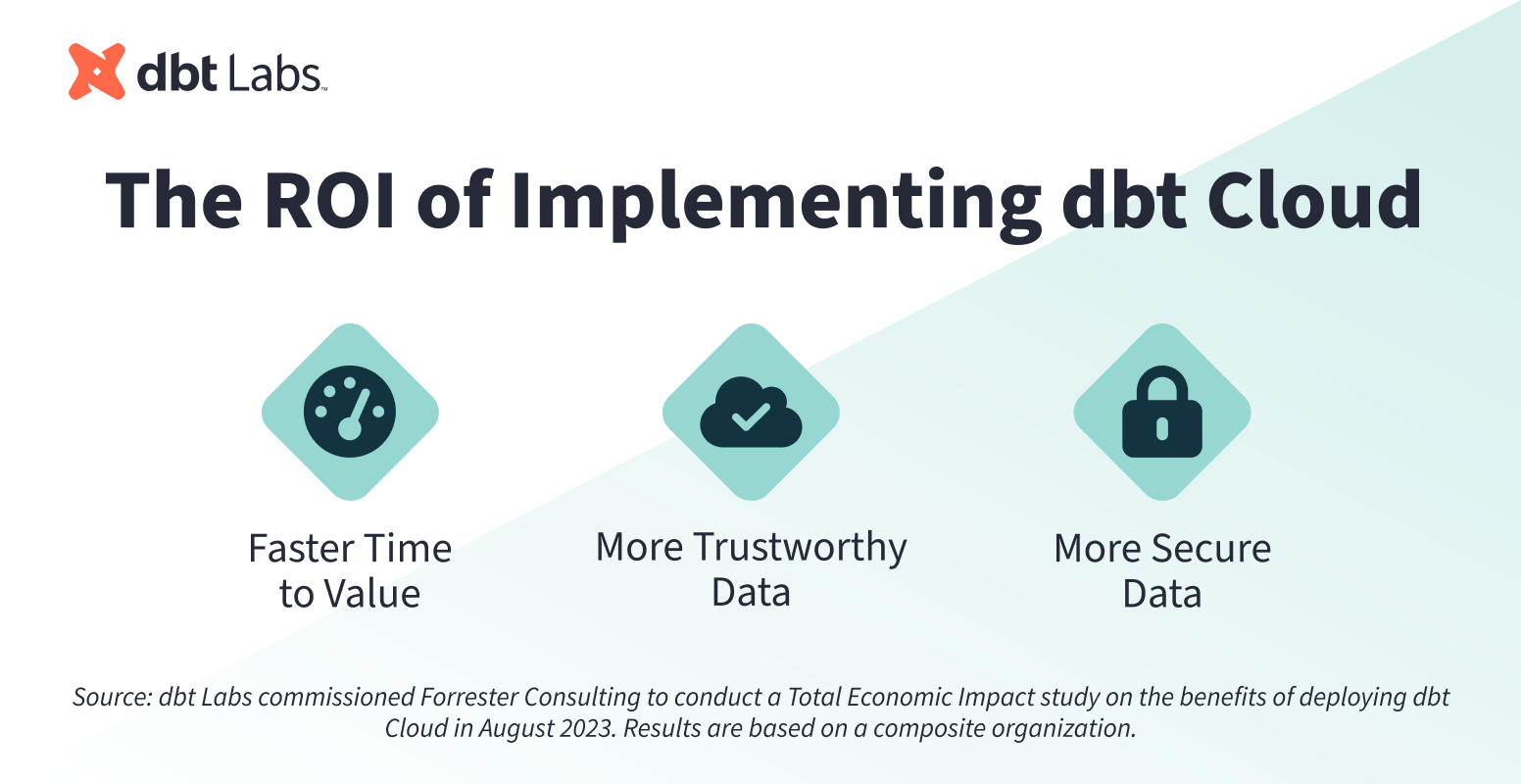The return on investment of dbt Cloud

Aug 25, 2023
Building Data Teams
Organizations have struggled to create trusted data within their organizations for years. While the problem of data ingestion is largely solved, data teams still struggle to make data transformations governed, accessible, and scalable. Most still rely on outdated methods using hand-coded stored procedures or drag-and-drop tools.
It’s time for data teams to invest in a new way of transforming their data. dbt Cloud enables data analysts and engineers to build trusted data products that enhance data project velocity, increase data quality, and increase collaboration.
But how much, exactly, can companies gain by adopting dbt Cloud? To measure this objectively, we commissioned Forrester Consulting to conduct an independent Total Economic Impact™ (TEI) study and examine the potential return on investment (ROI) enterprises may realize by deploying dbt Cloud.
[Download the full report here.]
The results? Forrester Consulting found a 194% return on investment (ROI) for dbt Cloud, with breakeven on the initial cost realized after the first six months of adoption. Accelerated workflows created a 30% boost in developer productivity, as well as a 60% savings in data rework time among engineers.
Meanwhile, data analysts saw an average 20% reduction in the time spent gathering and preparing data. Data transformation costs decreased by 20%, and every company surveyed reported increased trust in data and faster time-to-business value.
How can you realize these benefits in your own organization? Read on to learn more.
The problem that dbt Cloud solves
Before the advent of Amazon Redshift, companies managed their data pipelines on-premises using expensive Extract/Transform/Load (ETL) processes. The amount of storage and computing power required meant they could only import small amounts of data at any time.
The introduction of cloud-based data warehouses and data lakes led to explosive growth in data. Companies moved from ETL to more flexible ELT (Extract/Load/Transform) processes.
However, many organizations couldn’t take advantage of the full power of this shift. The main reason is that their processes didn’t change. Data engineers coded data transformations by hand, leading to replicated queries, duplicated data, and wasted compute cycles.
Meanwhile, data users didn’t understand where the data came from and felt like they had no control over it. Users wanted to own their own data pipelines, with minimal code and strong version control. They didn’t want to wait for days or weeks for the data engineering team to respond to their requests. They also sought clear tracking of data lineage and confidence that their data had been quality-checked.
dbt Cloud provides a centralized data transformation platform where everyone in the company can contribute to data in a governed manner. Using dbt Cloud, users can deploy transformations, metrics, tests, and documentation to manage their data. The platform runs transformation pipelines securely, storing no data in the service, and integrates with other tools—data catalogs, reverse ETL tools, observability, etc.—through its API and Semantic Layer.
dbt Cloud increases velocity, quality, consistency, and coordination for data products. For example, by leveraging dbt Cloud, US residential solar company Sunrun saw a 50% reduction in engineering tickets for complex data issues.
Forrester’s study
To gauge the impact of dbt Cloud, Forrester Consulting talked to four organizations that moved from an on-premises data pipeline solution to using dbt Cloud. The companies spanned multiple, disparate industries: commercial & residential construction; life sciences; energy, utilities, and waste; and B2B software.
(Note: Forrester Consulting created this study independently. dbt Labs had no involvement in discussions with these clients or with the model Forrester developed.)
From there, Forrester developed a composite organization to use as a benchmark for measuring the economic benefits of dbt Cloud. This idealized organization has:
- $2B in annual revenue with 5,000 employees
- 25 data engineers
- 200 data analysts
Over the course of several months, Forrester conducted interviews and gathered data to assess economic impact via its Total Economic Impact (TEI) methodology. Unlike straight total cost of investment (TCO) and return on investment (ROI) calculations, TEI looks at additional economic factors, including risk/uncertainty as well as strategic impact. Forrester has used their TEI model for over 20 years to measure the benefits, flexibility, costs, and risk of new technology solutions.
[Download the full report here.]
The findings: 194% ROI, benefits seen in less than six months
Benchmarking against the composite organization, Forrester Consulting found that dbt Cloud delivered a total return on investment of 194%. (That means for every dollar spent on dbt Cloud, companies realized $1.94 in savings and business value.) The total value of the investment came out to a net present value of $6.32M over three years.
How dbt Cloud addresses prior challenges
The organizations that Forrester surveyed reported using dbt Cloud to tackle a common set of challenges:
- Lack of consistency in data transformation approaches. Most teams were using legacy or DIY approaches to data transformation prior to dbt Cloud. This resulted in inconsistent or incorrect data as well as poor documentation.
- Extensive data rework. The level of rework required meant lost hours of productivity. It also raised the risk of data loss and created issues around securing access to sensitive data.
- Eroding trust among data analysts. Analysts didn’t know where their data came from, who modified it, or how it had last been modified. That meant they had no confidence they could use the data they had to make effective business decisions.
- Missed deadlines. These factors led to slipped project schedules, creating reputational loss with customers and stakeholders.
The four organizations in Forrester’s survey used dbt Cloud to:
- Re-establish trust in data
- Create flexible support for data transformation jobs that they can run on cloud data platforms
- Standardize data transformation processes across the organization
- Make data easy to locate and access via self-service tools
- Accelerate data-driven project development
With dbt Cloud, customers said they could develop, test, document, and monitor the progress of their data transformation pipelines in a way they never could before.
“[dbt Cloud] creates an assembly-line-type workflow for our data engineers and for the business to understand at what point their ticket request is at in development, approval, or deployment process,” said a data engineering manager at a commercial & residential construction firm.
Making the business case for dbt Cloud
No company will see the results of a major change overnight. In the case of dbt Cloud, the companies surveyed saw results during the first year as employees came up to speed on the new toolset and processes. As toolset and process maturity grow, so does the ROI.
We hear from many companies who say they want to improve their business-making decisions but don’t feel they have the right data. As the Forrester Consulting study shows, dbt Cloud can deliver concrete results in multiple areas of data-driven product development:
- Accelerate data product development to deliver more trusted data in a timely manner
- Standardize processes for data product development and releases to improve collaboration among data teams
- Securely increase self-service data analytics to foster more innovation and ownership of data products
Download the full report to see dbt Cloud’s four significant areas of ROI identified by Forrester Consulting.
Last modified on: Feb 21, 2024

Achieve a 194% ROI with dbt Cloud. Access the Total Economic Impact™️ study to learn how. Download now ›